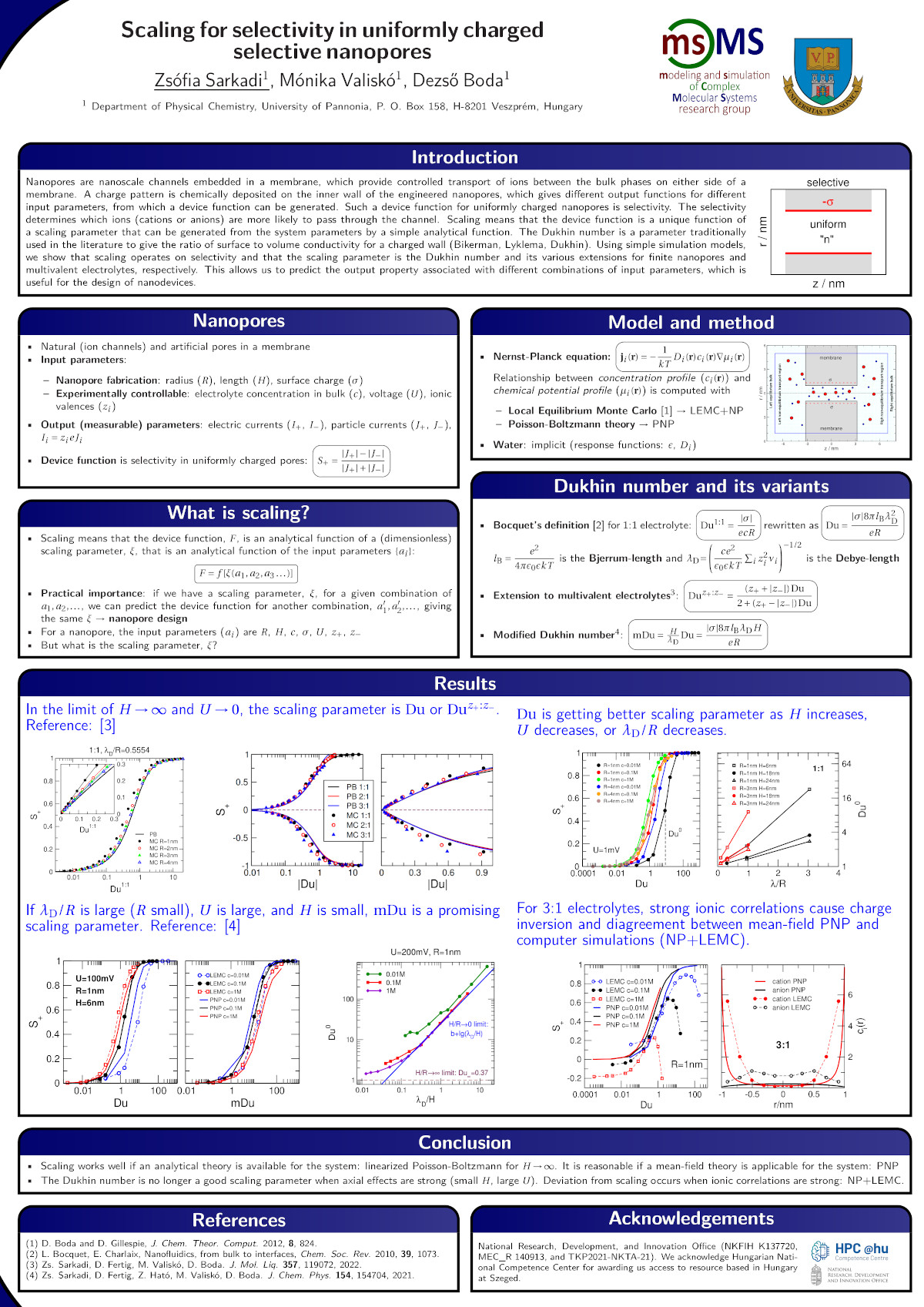“It is much easier with HPC – the world has opened up and we can run a huge number of simulations.” – interview with Zsófia Sarkadi, PhD Student with an HPC Grant

“It is much easier with HPC – the world has opened up and we can run a huge number of simulations.” – interview with Zsófia Sarkadi, PhD Student with an HPC Grant
How would you introduce yourself, and what is your field of research?
I graduated as a chemist and materials engineer. Now I am preparing for my chemical doctorate at the PhD School of Chemistry and Environmental Sciences of the University of Pannonia: I study nanopores. I work with very simple, reduced models: I apply the charges over the internal wall of a cylinder with rigid walls, the ions are rigid spheres, and the water is a dielectric background. As a result of a voltage difference, the ions will pass through the nanopore. The primary outcomes are ion currents, and I can draw conclusions from these.
What is the purpose of this research?
It is basic research in the strictest sense of the word. My PhD thesis work assesses the types of ions passing through the nanopores. Our research team wishes to create a function dependent on the input parameters, such as the length and radius of the pore, and the ion concentrations, that is, parameters that can be modified during the experiments. From this, we can compile a function which will be characteristic of these pores. This way, if we want to design another nanopore with different characteristics – such as with a different radius or length – in the future, then this function can be used to estimate its properties. Without assessing it via experiments or simulations, or possibly theoretical models.

Does this function represent a big step forward?
Yes, it will already have practical benefits when completed; you won’t need to conduct expensive and time-intensive experiments. This function will already be capable of selecting the nanopore likely meeting the expectations. We maintain relations with experimental research teams because, for example, ion channels in biological cells also work in a manner similar to our nanopores. But there is also a potential for electronic uses since this similarity also applies to semiconductors. This is a highly simplified model, which can be used for many different purposes.
When and how did you encounter supercomputing?
During my BSc studies, when writing my thesis paper, through Dr. Tamás Kristóf, who was my supervisor back then. Through Dr. Jadran Vrabec, he had access to a supercomputer called OCuLUS (Owl CLUSter) of the University of Paderborn, Germany; I learnt the basics on that machine.
Did your previous studies include HPC?
Specifically supercomputers – no. I had courses related to simulation during my MSc studies, but I didn’t have the chance to try and use it in practice although there would be a huge demand for that, I think. During the summer, I attended a simulation workshop in Paris; many came from the experimental field, I mean people who are pursue experiments. They also wanted to try and learn this. On the one hand, with a view to being able to communicate with those conducting simulations; on the other hand, it would be very important during the planning of the experiments to have an overview of the options in advance.
Is there an alternative to supercomputers in your professional field? Can such tasks be solved in other ways?
In brief: there isn’t. We don’t do experiments in this field, only theoretical simulations. The Department has a small cluster, Abacus, but primarily, it’s only suitable for orientational calculations. When more serious capacities are required because we are very curious, or are under the pressure of a deadline, the members of my research team also make use of their own laptops. It is much easier with HPC – the world has opened up and we can run a huge number of simulations. Now we don’t have problems any more with what to run or how to run, but we have a huge amount of data which needs to be processed.
Where did you hear about the grant tender of the Competence Centre?
My supervisors, Dr. Mónika Valiskó and Dr. Dezső Boda drew my attention to this as a future opportunity. Later, when I was searching for info about the time Komondor would arrive, I saw the grant invitation on the website, and submitted my application immediately.
How did you prepare for the use of HPC?
It was a huge opportunity, and I therefore carefully planned what I would be doing. Before, I specifically studied electrolytes with a certain composition. These have a 1:1 composition: the cation and the anion are a positive and a negative one, respectively, as are let’s say in the case of sodium chloride. In the past, we did preliminary simulations as to whether other electrolyte compositions may be even more interesting, because there are effects that emerge when the cation has a double or triple positive charge. I wanted to study these by all means, and HPC came in very handy for this.
Will you manage to reach the goal or goals set now?
Yes, absolutely. I could run the calculations I wanted, and what’s more, the results were even more exciting than expected.
Why did it become exciting?
In the past, we only studied cations with a single positive charge. But now simulating more complex systems requiring higher calculation capacities is not a problem any more, so I started to study electrolytes containing multivalent ions. That is, the system had ions with a double or triple positive charge and ions with a single negative charge. To simplify it to the extreme: I applied the negative charges over the internal surface of a cylinder with rigid walls, placed the ions into the block phase, and then applied voltage to the cell. Then these positive ions enter the channel, and get accumulated in the vicinity of the negatively charged wall, which make them shielded to some extent. Therefore, the negatively charged ions can also pass through the channel – this is called anion leakage. It is in vain to try to produce a more cation-selective pore by applying more negative charge over the wall – it won’t be more selective for cations because cations overcharge the wall, and that’s why anions can pass too.
Have supercomputers made you surprised in any way?
Of course, they only brought surprises. When I started to use them, I was still a BSc student, and it was a completely new environment. Especially because we learnt no IT skills at the University, let alone programming skills. However, after I got accustomed, it was very good that I didn’t have to wait, everything started immediately, and the results arrived within a relatively short period of time.
Did you need the experts of KIFU for now?
Yes. The website has very good descriptions, and when I was unsure of something, I wrote to them, and got immediate answers, whatever problem I had. For example, when I got stuck with the initialisation script, they immediately forwarded a few lines to me that made it work.
How did you manage to learn the use of HPC this way?
Getting the basic skills wasn’t difficult for me because my supervisor at the time and a PhD colleague helped me a real lot. A six-week summer practice made me reach a level where I could already confidently run my simulation. To change the code or to respond to error messages is a more serious task, and I’m still learning it.
So you learnt to use supercomputers in the practice, right?
Yes. I think you can learn the most when you have to solve a problem and you indeed manage to solve it. What’s more, I am in a lucky situation because Dr. Zoltán Ható, a member of my research team, has an impressive IT background; he is the first we turn to when we have questions.
To what extent do you think the use of supercomputers is challenging?
To get to know it on the user level and to use your own programs is not difficult.
What makes an efficient supercomputer user?
It requires planning in all cases, you can’t just start a task. You need to formulate the question and the way to the answer well. You need a good program for this. We use our own program, but you need to run it on the small cluster of the Department in a different way then on a supercomputer. I was lucky because our program was already optimised for both tools.
What is the biggest difference?
For me personally, it was the fact that I had to use different commands and I had a few times when I mixed up what works where. In addition, supercomputers also have architectural differences, and you also need to adjust to that.
For whom would you recommend the use of supercomputers?
For everyone! A large number of research teams use them for planning their experiments, but it is also worth considering them for those working with huge amounts of data. And in the field of research and development, anyone could make use of them, without exception.
Would you like to use HPC in the future too? Do you possibly have any project ideas for Komondor?
Of course! I am very much looking forward to Komondor. My field is only about simulations, and I can only imagine myself working in this field in the future, after completing my PhD. We have a great number of new plans that we want to test.
How do you see the future of supercomputers?
This field is under a very intensive development – we can expect great advances even if it only continues at this speed. And I can’t even imagine the limits when quantum computers will be available. Of course, quantum computers will not replace HPC, because they are simply for other purposes, but I want to try them by all means.


